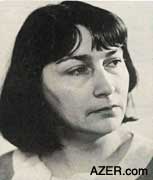|

Spring 2003 (11.1)
Pages
54-59
Shostakovich's Tenth Symphony
The Azerbaijani
Link - Elmira Nazirova
by Aida Huseinova
Above: Elmira Nasirova, the inspiration for
Dmitry Shostakovich's Tenth Symphony, as revealed in his correspondence
to her. He incorporated the musical notation of both of their
names in the Third Movement.
See also: "Melodic Signatures in Shostakovich's 10th Symphony," by Aida Huseinova, Azerbaijan International, Vol. 11.1 (Spring 2003), pp. 54-59.
This year marks the 50th anniversary of one of the greatest musical
masterpieces of the 20th century - the Tenth Symphony in E minor,
opus 93 by Dmitry Shostakovich. It is significant to note that
it was written in 1953 a few months after the death of Stalin,
who had ruled the Soviet people with an iron hand for 31 years.
Many critics suggest that Shostakovich's works stand as one of
the strongest testimonies to the strength and morality of his
character, especially given the brutality of Stalinism. Like
all intellectuals of the period, Shostakovich suffered immensely
under this regime, perhaps, even more so, because of his high
profile.
At the peak of Shostakovich's career in the 1948, when he had
already been identified internationally as one of the giants
in 20th century music, the Communist authorities censured and
blacklisted him. The Party had set forth a Decree against Formalism
criticizing those Soviet composers who focused on the symphonic
genre. They strongly urged them to turn to create text-related
music such as the opera, musical comedy or cantata. The true
intention was clear though: music censors were never too sure
what the symphonic composers were exactly trying to convey because
the meaning was open to interpretation; whereas, in musical theatrical
works and vocal pieces, the story line could be easily monitored.
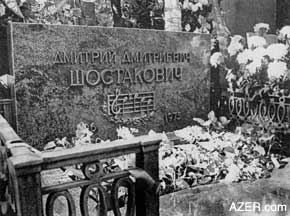  Left: Grave of Shostakovich in Novodevichy Cemetery,
Moscow. Note his musical signature which appears in the Tenth
Symphony and various other orchestral works. Left: Grave of Shostakovich in Novodevichy Cemetery,
Moscow. Note his musical signature which appears in the Tenth
Symphony and various other orchestral works.
The Party's censure
was an immense psychological weight on Shostakovich. One of the
most obvious places was the decline in his productivity. Symphony
No. 10 had been written in 1953, eight years later than No. 9
- an immense gap for a composer as prolific and focused on this
genre as Shostakovich.
Discoveries related to the personal aspects of his Tenth Symphony
comprise one of the most interesting stories to emerge within
symphonic studies in recent times.
The revelations by Nelly Kravetz in 1994 surrounding the contents
of correspondence between Dmitry Shostakovich and Elmira Nazirova,
a pianist and composer from Azerbaijan, have resulted in a number
of books and articles that have appeared in which aspects of
the Tenth Symphony can now be viewed in the light of new biographical
data: broadly speaking, the emotions the composer experienced
towards his former student and the place these emotions forged
themselves in his Tenth Symphony.
Today, these letters are with the family of Dmitry Shostakovich
in the United States. Not so long ago, Elmira Nazirova personally
confided their contents with Aida Huseinova, one of her students.
The Story Revealed
I'll never forget the day: it was late in August 1990. Elmira
Nazirova, one of Azerbaijan's most respected pianists and gifted
composers was closing a chapter of her life and anticipating
her move to Israel as an emigrant. "We need to talk, Aida",
she told me over the phone. "It's really important. Can
you stop by my place?"
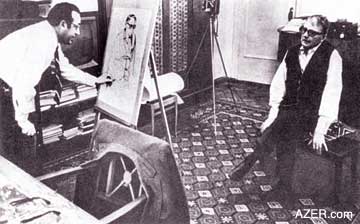  Left: Azerbaijani artist Tahir Salahov painting
Shostakovich's portrait, 1974-1976. For more of Salahov's works,
visit AZgallery.org. Left: Azerbaijani artist Tahir Salahov painting
Shostakovich's portrait, 1974-1976. For more of Salahov's works,
visit AZgallery.org.
The thought of Elmira's
leaving left many of us in the music world of Azerbaijan saddened;
it was a great loss for us: she had been one of the key figures
in the piano culture of Azerbaijan.
Decades earlier she had toured many countries, evidence of her
incredible performance talent.
She was revered and loved as one of the most respected professors
at Baku's Conservatory - a woman who had influenced and shaped
the careers of so many youth who would later become prominent
pianists and teachers not only in Azerbaijan but also in Germany,
Russia, Turkey, Mexico, Israel and other countries. We also respected
her as one the first women composers in Azerbaijan.
Elmira khanim [an endearing term of respect, meaning Lady] and
I were amazingly close, despite the differences in our ages:
She was 62, I was 26 at the time. I had already known her for
nearly half of my life, having started piano lessons with her
at 14 while studying at Bulbul School. I considered Elmira khanim
my genuine spiritual mentor as she had already had a tremendous
influence in my life, both as a musician and as an individual.
And so I stopped by her apartment in downtown Baku, not knowing
what to expect but knowing that this would be one of the last
times I would see her before her departure.
"I have something important to share with you because I'm
leaving," she began. "As I'm an Azerbaijani, naturally,
I want this information to be known here in my Motherland."
I was already a musicologist by that time and, perhaps, that's
why she confided in me, realizing that one day it would be appropriate
to tell her story - so that it wouldn't be lost.
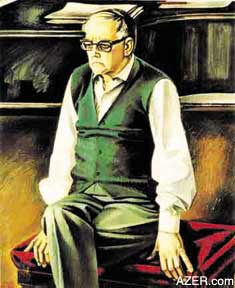  Left: The completed painting of Shostokovich
by Tahir Salahov. Left: The completed painting of Shostokovich
by Tahir Salahov.
This was my introduction
to another world that had remained hidden beneath the surface
in Elmira's life. I was aware that Shostakovich had been Nazirova's
mentor in composition class and that they had maintained very
warm relations afterwards. For years I had admired his portrait,
hanging on the wall in her study, which he had personally autographed,
"To dearest Elmira from Dmitry Dmitriyevich". Quite
appropriately, our conversation took place in the presence of
that photo.
Revelations
When she opened her heart, I can't say that I detected excitement
in the disclosure but rather that her eyes expressed what seemed
to me an immense sense of relief, of finally being able to reveal
such a deep secret that had been so meaningful and precious to
her, after almost 37 years of silence.
"Everybody knows how complicated emigration can be,"
she told me that afternoon, "especially with customs and
immigration. I really don't know what might happen to these letters
and want you to read them now: I hope you'll write this story
some day." Elmira khanim brought a pile of Shostakovich's
letters and let me read them. I knew his handwriting from some
of his published scores - nervous, jerky and actually quite difficult
to read. It reflected his personality, full of emotion and passion.
The content of the letters was quite a shock for me. And so the
story began to unfold of Dmitry Shostakovich's love for her -
sincere, pure and quite desperate. I wondered when and in what
circumstances they had met? How had their relationship grown?
What were the facts surrounding this episode of the composer's
life and how were they incorporated in his composition of the
Tenth Symphony?
Teacher and student had first met in the autumn of 1947 in Moscow.
By that time, Elmira was already known in Azerbaijan as a promising
young musician. In her youth, she had been considered a child
prodigy at Baku Music School, which was under the umbrella of
the Azerbaijan's Conservatory, Elmira had been admitted to a
separate group for gifted children alongside Chinghiz Sadikhov,
a renown pianist and accompanist and Bella Davidovich, a world-reputed
pianist and professor, laureate of the Chopin International Piano
Contest.
Her first professional achievements were so impressive that in
1942, at the age of 14, she was invited to join Azerbaijan's
Composers' Union! In 1944 Elmira presented her Piano Preludes
during the 'Decade of Music of the Transcaucasian Republics'
in Tbilisi, Georgia, where her composing and performing talents
were highly regarded by many prominent Soviet musicians including
Reinhold Gliere.
Uzeyir Hajibeyov, revered in Azerbaijan as a national genius
and the founder of classical composed music in the country, had
been a determining influence in Nazirova's life, encouraging
her to continue her education at the world-reputed Moscow Conservatory.
That's how Elmira came to study piano there with Yakov Zak, and
composition with Dmitry Shostakovich.
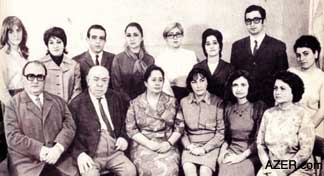  Left: Music Faculty at Baku's Conservatory
of Music, 1971. Sitting (from left): Rauf Atakishiyev, Mayor
Brenner, Nigar Usubova, Elmira Nazirova, Aliya Mirzoyeva, Jamila
Muradova. Standing (from left): Saida Behbudova, Vafa Aliyeva,
Ogtay Abbasguliyev, Zemfira Shafiyeva, Adila Vakilova, Tamilla
Gasimova, Tarlan Seyidov, Gulnar Sadikhova. Left: Music Faculty at Baku's Conservatory
of Music, 1971. Sitting (from left): Rauf Atakishiyev, Mayor
Brenner, Nigar Usubova, Elmira Nazirova, Aliya Mirzoyeva, Jamila
Muradova. Standing (from left): Saida Behbudova, Vafa Aliyeva,
Ogtay Abbasguliyev, Zemfira Shafiyeva, Adila Vakilova, Tamilla
Gasimova, Tarlan Seyidov, Gulnar Sadikhova.
She spoke nostalgically
of the rare atmosphere that characterized his classes, where
students were encouraged to delve into the inner workings of
composers' creative minds, where heated discussions developed
on a wide variety of issues - not just those related to music
- but in literature and art as well. She remembered performances
of Haydn and Beethoven symphonies being played on two pianos.
A few months after her arrival in Moscow, Shostakovich was to
face what would be the most trying period of his life. A decree
was made by the Communist Party, severely criticizing Shostakovich
and others for what they felt were their superfluous focus on
writing symphonic and dissonant music; that is, music without
melody, containing "rough" harmonies. It was a terrible
time for the great composer. They even dismissed him from the
Moscow Conservatory. Msitislav Rostropovich recalls how he entered
the Conservatory and read the announcement that Shostakovich
would not be returning as their professor. Everyone was in shock.
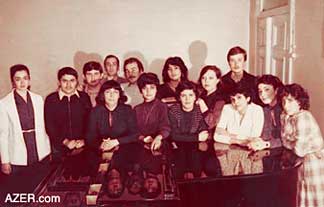  Left: Elmira Nazirova, 3rd from left, with
some of her piano students in Baku. Aida Huseinova, author of
this article, is to the right of her teacher and mentor, 1983. Left: Elmira Nazirova, 3rd from left, with
some of her piano students in Baku. Aida Huseinova, author of
this article, is to the right of her teacher and mentor, 1983.
During that time, Nazirova
remembers how, during one of the concerts in the Bolshoi Hall
at the Conservatory, she chose a seat somewhere near Shostakovich
or, more precisely, within the 'vacuum' around him. The composer
acknowledged her presence and asked, "Aren't you scared?"
In 1948, after her marriage to Miron Fel, a student of the Azerbaijani
Medical Institute, Elmira returned to Baku and resumed her studies
in the Azerbaijani Conservatory with Georgiy Sharoyev (piano)
and Boris Zeidman (composition). But the intensely active musical
life of the former Soviet Union soon brought her into contact
with her mentor again. Shostakovich's close associations with
many Azerbaijani musicians led him to pay frequent visits to
Baku.
It's important to mention Shostakovich's links with Azerbaijani
music. Gara Garayev and Jovdat Hajiyev, two of Azerbaijan's finest
composers, had studied with Shostakovich at the Moscow Conservatory
and always admitted their mentor's influence, not only on their
own personal music style but also on the development of Azerbaijan's
music culture. According to Garayev, Shostakovich, along with
Hajibeyov were the decisive musical personalities that shaped
what became a flourishing Azerbaijan school of composers.
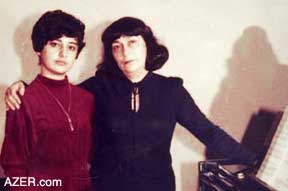  Left: Aida Huseinova (left), author of the
article, with her piano teacher and mentor Elmira Nazirova in
1983. Shostakovich incorporated Elmira's musical signature into
his Tenth Symphony. Left: Aida Huseinova (left), author of the
article, with her piano teacher and mentor Elmira Nazirova in
1983. Shostakovich incorporated Elmira's musical signature into
his Tenth Symphony.
In 1952 Shostakovich
visited Baku twice: in March he participated in a concert of
his own works, and later in December, he attended the premiere
of the ballet "Seven Beauties" by Gara Garayev, former
student and close friend. Elmira, in turn, went to Moscow, to
participate in various projects organized by the Soviet Composers'
Union: discussing professional issues with her colleagues from
the Moscow Conservatory, and giving public performances. In 1951,
together with Sviatoslav Knushevitsky, the great Russian cellist,
she performed her Cello Sonata in the Small Hall of the Moscow
Conservatory. And so again and again she met with her mentor,
her own special listener who remained a severe and demanding
critic.
Nazirova rejected the idea of ever being aware of anything different,
or special in Shostakovich's manner in relating to her at this
time. "I could never have imagined anything of that kind
- I was so abashed in his presence!" she explained to me.
"And he never verbalized his feelings."
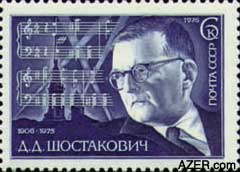  Left: Six-kopeck stamp commemorating composer
Dmitry Shostakovich (1906-1975), issued by the USSR on his 70th
Jubilee in 1976. Left: Six-kopeck stamp commemorating composer
Dmitry Shostakovich (1906-1975), issued by the USSR on his 70th
Jubilee in 1976.
However, certain emotions,
perhaps unconsciously at first, had already begun to emerge in
Shostakovich's awareness of her. How else can one explain the
paragraph in a letter to her, dated July 29, 1953, where he describes
his excitement of noticing Elmira among those who had come to
greet him in Baku.
Their relationship evolved at this time into one of a new and
ever-growing intellectual intimacy. They met frequently, took
long walks, listened to Beethoven and Mahler symphonies, and
argued about various issues related to music and life. Shostakovich
made suggestions to Elmira about her new compositions, and encouraged
her to turn her attention to specific genres or forms. At the
same time, he shared his own creative ideas.
Nazirova still treasures the musical scores of Shostakovich's
Preludes and Fugues, the Seventh and Eighth Symphonies, as well
as Robert Schumann's Frauenliebe und -leben, which the composer
personally presented to her, along with his handwritten dedications
and signatures.
First Letters
On April 4, 1953, Elmira received Shostakovich's first letter,
in which he mentioned misprinted errors in the first edition
of his Preludes and Fugues. This was the beginning of a correspondence
that would last for three and a half years.
Shostakovich shared his philosophical ponderings about the ironies
of life, the essence of the composer's work in general and how
they correlated with his own experiences. But above all, these
letters reflect his incredibly profound and complex feelings
in which love and admiration for Nazirova were combined with
the deepest respect and appreciation for her professional ability
and success.
Sometimes he chose a humorous way to express his feelings: in
a letter from June 21, 1953, he simply includes the music phrase
from Lensky's Arioso from Tchaikovsky's Eugene Onegin with its
original words, "I love you!" Here, too, he expresses
his great interest in the works Nazirova was composing at the
time - Variations for Piano, etudes, a piano concerto and other
works, asking about the details of her own compositional process.
Indeed, he had a strong belief in her as a gifted composer: "I
hope you will compose a great deal of music and become a true
composer. You have all the prerequisites", he wrote on January
25, 1954.
In another letter, from August 29,1953, he expresses his sincere
interest in her composing and performing activities: "I
feel so pleased that you are playing Beethoven's Fifth Concerto
and plan to perform it along with the Fourth. Take advantage
of being a great pianist and do play many wonderful works. And
don't hesitate to borrow from them. Then you will become a great
composer. Make sure you borrow, not copy. There's a huge difference.
Try to understand and discover the secrets of the great masters.
I'm sure you know them yourself. I am impatient to receive the
Variations and Etudes that you have promised."
He describes his feelings toward Elmira as "the most important
event" in his life at the time (July 25, 1953). "I
am missing you very much. If you don't think about me negatively,
please write. I feel very bad and upset. A word from you will
help me to recover" (November 2,1953).
Shostakovich valued her thoughts and opinions of his own compositions:
"I would like to show you those of my works that you probably
don't know. And I would be very happy to get to know your opinion
about them. And perhaps even more desperately, I would love to
see you. If your works happen to be published before visiting
Moscow, please send them to me" (July 25, 1953).
It was in that same letter that he informed her about starting
his Tenth Symphony. From this day onward, the frequency of their
correspondence intensifies. From June 25th to October 30th, Elmira
received 18 letters. The composer informed her about each step
of his work in progress. He alludes to the apparent impasse that
would come of their relationship, "Will our paths ever get
meet? Perhaps, never. There are many, too many, reasons for that"
(July 29, 1953).
Music Signatures
In a letter of August 10, 1953, he tells her about his "seeing"
or, more precisely, "hearing" the music of the Third
Movement, Allegretto, in a dream. Eleven days later, she received
the stunning news that he had depicted her name in the melody!
"This is the result", he writes in this letter. "Even
if I had not arrived at such, I would be thinking of you constantly
- whether or not this fact is recorded in my worthless manuscripts".
Essentially, he had introduced two alternating musical signatures,
D-Es-C-H and E-A-E-D-A alluding to the depth and profundity of
his feelings, expressed as the enigmatically beseeching qualities
of the motif E-A-E-D-A, that denoted its unattainability. In
his letters, he describes precisely how he arrived at each note
in her name [See sidebar].
For many years, so many critics puzzled over these dominant musical
phrases in the Third Movement: What did they mean? Some analysts
guessed that they were calls; others interpreted them as a description
of nature. Others suggested, though unconvincingly, that they
were a portrait of Stalin. Nobody imagined what the real meaning
was.
The composer invited Elmira to the Moscow premiere of the Tenth
Symphony which took place on December 28, 1953 in the Bolshoi
Hall of the Conservatory. The performance was directed by Yevgeny
Mravinsky. Elmira told me that she felt the composer's constant
gaze upon her during the entire performance. A year later, the
symphony would be performed in Baku conducted by Abram Stasevich.
Shortly afterwards, a copy of the score, arrived at the Azerbaijani
Composers' Union, along with the Shostakovich's request to pass
it on to the recipient. The copy had been addressed to Elmira
Nazirova. Of course, it caused quite a stir among the music hierarchy,
who were puzzled how such a nationally distinguished figure would
bestow such an honor on this young colleague from Azerbaijan.
Naturally as time passed, the correspondence between the two
musicians gradually lessened. In 1954 Elmira received only five
letters; in the following two years, only one each year. In his
final letter dated September 13, 1956, Shostakovich informed
her of his marriage to Margarita Kainova since composer Nina
Vasilyevna Varzar, the woman who had been his wife when he knew
Elmira, had passed away in December 1954.
Nazirova as Musician
For Nazirova, the mid-1950s signified a period of important professional
accomplishments. She undertook extensive tours as a pianist,
traveling through Russia, Georgia, Poland, Czechoslovakia, Egypt
and Iraq, performing with various orchestras conducted by Niyazi
(Azerbaijan), Rakhlin, Stasevich (Russia) and Satanovsky (Poland).
Nazirova also achieved success as a composer; for example, her
Etudes, the Piano Concerto on Arabic Themes, and the Suite for
Two Pianos on Alban Themes (these last two pieces being co-authored
with Fikrat Amirov) were recognized as of significant importance
in the development of piano music in Azerbaijan. In 1971 Elmira
Nazirova became Professor at the Azerbaijani Conservatory, and
in 1972 she was appointed as Chair of the Piano Department. Her
activities gained official recognition and she was awarded the
title of Honored Art Worker of Azerbaijan.
Later, by attending various music forums throughout the Soviet
Union, she chanced upon Shostakovich a few more times, though
rather infrequently. In March - April 1956, Shostakovich attended
the First Assembly of the Azerbaijani Composers' Union as an
honored guest; in May 1964 he participated at the "Decade
of Russian Culture" in Azerbaijan. Circumstances also brought
them together in July 1968 during a summer vacation at the Composers'
Union Resort Centre in Diligan, Armenia.
They appear to have met for the last time in October 1972 (three
years before his death) in Baku during the "Decade of Russian
Literature and Art". Of course, the heightened emotions
of the 1950s were now assigned to a distant past; yet there would
remain forever a secret that united their two hearts together.
The musical world has long honored figures such as Clara Schumann,
Meta Abegg, George Sand, Mathilde Wesendonck, Harriet Smithson,
Emma Debussy as muses of the great composers, becoming the important
part of their biographies and music legacy. However for various
reasons, Shostakovich was not able to reveal the secret of the
Tenth Symphony. Primarily, it seems he was guided by his ethics
not to disrupt the peace in their respective families. Besides,
such a "frivolous" musical dedication as that expressed
in the Tenth would have run counter to the dogmas of Socialist
Realism, contradicting the very image of the Soviet composer.
Works were usually dedicated to Lenin, to the Party, possibly
to friends or parents, but never to a woman who happened to have
inspired them.
All the same, the true story behind the Tenth Symphony has finally
been revealed, despite the secrecy maintained for nearly half
a century. The story of the genius Shostakovich and his idealized
love is now written in music history. It is depicted through
the reminiscences of a gracious, and immesnely talented woman,
distinguished by her charisma and unbelievable magnetism. It
is reflected in these precious manuscripts - the stiff, yellowing
letters that the great composer penned to her.
And, most of all, it remains symbolized in the immortal music
of the Tenth Symphony where these two musical signatures - Dmitry
Shostakovich and Elmira - remain intertwined forever.
Aida N. Huseinova is Associate
Professor of Musicology at Baku Music Academy. She has a Ph.
D in Musicology from St. Petersburg State Conservatory (1992).
In 2000-2002 she was a visiting scholar at the School of Music
at Indiana University (Bloomington) .
She has more than 40 publications, including three books: "Muslim
Magomayev: Opera Works" (1997), Co-editor of "Farhad
Badalbeyli: Articles and Materials" (1997) published by
Gapp-Poligraf, and "Music: A Temple of Sincerity Encyclopedia
of Music" with Ayna Publishers, 2000.
Back to Index
AI 11.1 (Spring 2003)
AI Home
| Search | Magazine
Choice
| Topics
| AI Store | Contact us
Other Web sites
created by Azerbaijan International
AZgallery.org | AZERI.org | HAJIBEYOV.com
|

